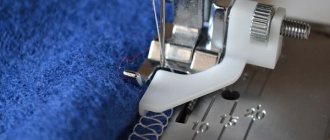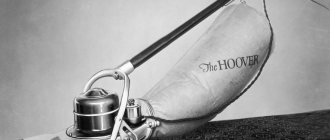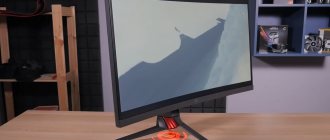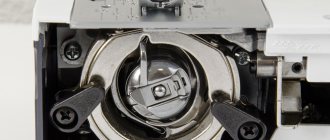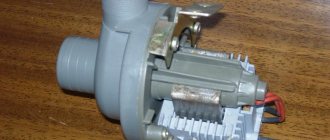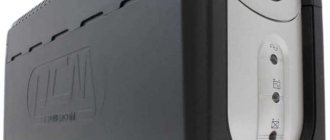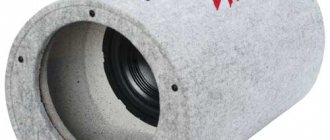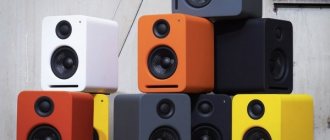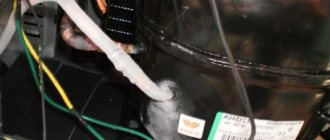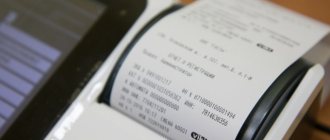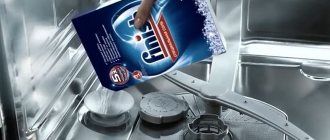What is overlock?
What is an overlocker and what is it for? Overlock refers to the types of sewing machines that are used to overcast sections of any textile materials. This process prevents the stitching of the material from unraveling and gives them a graceful appearance. Wrapping is accompanied by cutting off excess fabric, and some overlockers have a function for stitching product parts, which involves stitching a chain seam. They can perform different types of stitches:
- Classic.
- Decorative.
Overlock image.
Features of work
It is incorrect to ask the question about what an overlock is in a sewing machine. She creates an imitation using a simple zigzag stitch. When tensioned, the threads may break. The result is poor quality processing. This is the main reason to purchase a machining machine. But if this is not possible, it is recommended to know the features of working on a machine with such a stitch.
You might be interested in this: Patterns and sewing of blouses and dresses for peasant women
A novice seamstress should know that it is worth processing the edges of products using a foot for these purposes. Each type of stitch is suitable for different purposes. For bed linen, for example, oblique imitation should be used.
Sewing machine with overlock stitch
Types of classic seams
You can process the edge of the product using a regular sewing machine, but seams made with an overlocker are much more aesthetically pleasing and of higher quality. It provides for the implementation of 2, 3, 4, 5 thread stitches.
From two threads
Double thread threads are designed for very thin fabrics where you need to use a minimum number of threads. Since overlockers most often require the use of 3 threads per stitch, you need to make sure that this model has a converter. It looks like a special clip that covers the upper looper. To make a 2-thread seam, one needle and one lower looper are sufficient. The needle makes stitches from above, the lower looper is parallel to the bottom, and the upper looper connects 2 lines using a thread spiral. It can be used for fabric with any structure.
Image of a 2-thread stitch.
From three threads
The three-thread stitch is the most common and is performed both on a modern overlocker and on an old one. These are the most economical machines, since if 3 threads are enough for a future product, you can significantly reduce sewing costs. The stitching is done using simple technology.
Image of a 3-thread stitch.
From four threads
Using a four-thread stitch makes it possible not only to overcast the edges, but also to stitch together pieces of fabric. It is most suitable for stitching knitted items. To sew a knitted seam, two needles and two loopers are used. It can be used to process elastic fabrics.
Image of a 4-thread stitch.
Of five threads
Five-thread stitches on modern overlockers are performed with three needles. It can also be done on a carpet stitcher, which has a special lower looper for making chain stitches. It is best used for capricious fabrics, especially where a zipper or a large brooch is provided.
Image of a 5-thread stitch.
What can you sew on an overlocker?
Not all needlewomen practice sewing on a home overlocker. Most often, it is used to create bed linen. Perhaps tablecloths and curtains. Therefore, it is difficult to find information on how to sew knitwear using an overlocker for any occasion.
At the initial stages, you can sew pillowcases for fun. And then look at the difference between an overcast seam and a simple one. Draw a conclusion after several months of use. The easiest way to get a knitted set of underwear.
You might be interested in this: The procedure for sewing a one-piece swimsuit for an overweight woman on your own
Sometimes knitwear can be overlocked
Types of decorative stitches
Modern models of overlockers provide great opportunities for making unique products thanks to several types of seams. These include:
- Role-playing.
- Flat.
- Double sided.
Role-playing
Rolled seam on an overlocker - what is it? In some sources it may be called roller or opiss. To obtain it, manipulations are carried out in which the tensioner in the overlock machine is adjusted. The final result of the finished edge appears to be curled inward. This makes it possible to create a wavy frill. And inserting fishing line into the edge of the skirt will make it elastic. If you use this maneuver to overcast the petticoat, you can get a fuller hem. The rolled seam not only processes the edge of the fabric, but also sews the frills of the suit. This hem is often used when sewing dance costumes. This seam fits harmoniously on decorated parts of tulle and knitwear.
Image of a rolled seam.
A roller seam is performed by reducing the stitch length to a minimum and changing the stitch width. All overlockers have a special tongue located near the needle plate. During sewing, it is positioned so that it is surrounded by the top loop on one side and the fabric on the other. Thanks to this, the edges of the fabric do not curl and the stitching is done in the same width. To obtain a roller stitch, simply remove this tongue. Then you will get a line with a minimum width (about 2 mm), and the edges of the fabric will be curled inward.
Flat
Real flat stitching is done not with an overlocker, but with a cover stitching machine. This is a completely different type of sewing stitch, which is formed differently from the overcast stitch. Some types of overlock machines have a flatlock function. It makes it possible to obtain only a stitch that is visually similar to a flat seam. You can make a real cover seam using carpet lockers. However, the price of such machines is much higher than others, so not everyone can buy them. In this case, you can use an imitation of a flat stitch on an overlock machine.
Image of a flat seam.
The flat type is a decorative function, useful in the process of designing the hem of the lower part and sleeves of the product. It is also suitable for processing cuts on thin fabrics, stitching knitted parts and trimming excess. To perform a stitch, you need to have a special foot designed for this work. Some models come with it right away, while others require a separate purchase. A flatlock seam on an overlocker can be done with two or three threads. Each machine has different capabilities. Stitch parameters may also differ. If the connection is made with the right needle, then the stitch will be narrow, and if with the left, it will be wide.
Flatlock image.
Bilateral
Double-sided seams (also called flat top stitches) can only be made using modernized equipment that allows you to use a large number of threads at once. Threaded threads are intertwined in quantities of 5 to 10 pieces, and thanks to the resulting beautiful stitches, products with beautiful prints are created. Double-sided stitches are not intended for edge stitching; they are used to create decorations for clothing.
Since the overlocker has many capabilities and processes overcast stitches with high quality, in addition to the sewing machine, it is recommended to purchase an additional overlocking device.
Image of a double-sided seam.
Overlock, carpet lock, stitching and sewing: what is the difference?
Having understood the features of machine rolled hem, it is worth finding out what kind of machine it is sewn on and why it cannot be fully reproduced on others. To do this, it is important to know the differences between an overlocker, a carpetlocker, a sewing machine and a sewing machine.
To begin with, it is important to remember what types of machine seams there are. Regardless of their level of difficulty, they are all divided into 3 main categories.
- Connecting. Designed to connect two or more parts of matter.
- Regional From the name it is clear that they are made only on the edges of the product. Most often, all types of such seams are designed to protect the fabric from fraying and maintain the integrity of the product.
- Finishing or decorative.
The sewing machine is designed to perform connecting seams. Less often finishing. Of course, more expensive and multifunctional devices are capable of not only sewing fabric, but also processing its edges with a zigzag or something similar. However, they are significantly inferior to professional edge seams, since they stretch the material or deform it.
An overlocker is designed for making edge seams, which is why it is sometimes called an “edge overcasting machine.” Thanks to a special system of feeding and weaving threads, most of these machines not only do not deform the fabric, but are also equipped with special knives that cut off excess, thus providing a beautiful stitch.
Depending on the number of threads, these types are distinguished.
- Double thread.
- Three-thread overlock.
- Four-thread.
- Five thread overlock.
On any of them you can make an opirovka.
If a sewing machine and an overlocker are the bread and butter of anyone who is seriously interested in sewing, then a ripper (flat-sewing machine or flat-sewing machine) can be compared to red caviar on top of the same sandwich. You can do without it, but it’s much better with it, especially if you often have to work with knitwear.
To better understand how she sews, you should pick up any T-shirt or T-shirt. In the vast majority of cases, its edge is folded and stitched with a sophisticated double-sided seam. It is for carrying out such operations that a flat-seam stitcher is used. The seams she makes can be classified as both decorative and connecting.
In addition to the three main sewing whales, in this area there is also such a device as a carpet lock. This is a hybrid that combines the functions of an overlocker and a stitcher.
Tips for choosing seams
The overlock machine has all the capabilities to carry out work that allows maximum maneuverability when creating overcast stitches. When choosing a machine and stitch, keep the following in mind:
- If you buy an overlocker only to overcast edges, then you can limit yourself to a machine that allows you to work with two or three threads. And if you plan to make products with decorative stitches, then it is better to purchase an overlocker with a four-thread overlock.
- The presence of a differential feed option makes it possible to process elastic fabrics and produce assembly elements or flounces.
- Due to the fact that the width of the cut is adjustable, it is possible to make one seam in different versions.
Thanks to the variety of stitches produced by overlocking machines, you can implement any sewing idea and achieve a good result in your design solution. The main thing in this matter is to have a high-quality overlocker that satisfies all the needs of the seamstress.
You can also find out which sewing machines are considered the best.
Thread tension levels
When using a rolled seam on an overlocker, the photo of which you see in the article, the degree of thread tension is very important for overcasting fabric sections. By adjusting the tension, stitches of different appearance and quality are obtained.
Adjustment is carried out with a special wheel. Some models of overlockers in a more expensive price category are equipped with an automatic adjustment system. She independently sets the parameters based on the desired seam.
In simpler overlockers, tension regulators (wheels) are located on the plane or on one of the axes, which allows for uniform tension on all threads.
Double thread seam
Most modern overlocker models perform processing using two threads. A two-thread rolled seam can also be made on a machine if it is equipped with a special converter, which looks like a metal bracket that is put on the upper looper. When a stitch is formed, the needle thread and the lower looper thread are used. The function of the upper one is to transfer the lower thread to the needle, which contributes to the formation of the correct stitch.
The main advantage of this type of seam is its smaller volume compared to others.
Area of use: processing of thin and delicate fabrics.
